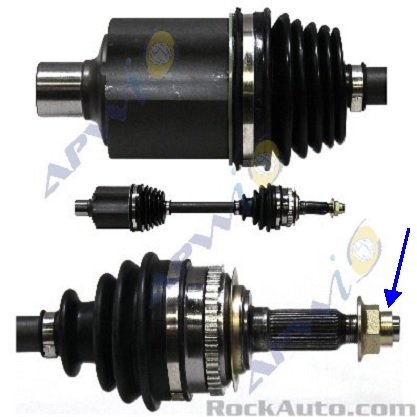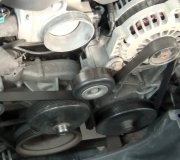Something else you might consider is a worn inner CV joint housing. Typically this is observed from 0 to around 30 mph, and only during periods of acceleration, such as when accelerating onto a road from a parking lot. This can also start occurring right after an engine mount is replaced, or other service is done involving the mount that positions the engine sideways in the engine bay.
There's six highly-polished rolling surfaces inside the inner CV joint housing, and three large rollers that run back and forth on them as the half shaft changes length and angle. Over time those rolling surfaces can wear down very slightly. Most of the time you won't notice that, until something is done that changes where those rollers are running within the housing. That can include working with the engine mounts, replacing sagged front coil springs, even adjusting "camber" as part of an alignment.
When anything is done to cause the rollers to shift slightly to a new orientation, as the half shaft rotates, those rollers run out of the worn areas, then back into them. They bind when they try to run up out of the worn spots. Binding prevents the shaft from changing length as it rotates and as the car goes up and down over bumps in the road. Instead, it puts pressure on the wheel bearing and steering knuckle. That pressure is transferred through the ball joints, then to the control arms which are mounted with rubber bushings. Those soft bushings allow the spindle to be pushed sideways, and since that is attached to the steering linkage, you'll feel that as a miserable shaking in the steering wheel. The binding half shaft also tugs and pushes on the transmission and engine, and you'll feel that in the entire car.
The biggest clue is the shaking stops when you're no longer accelerating. During cruising and coasting, there's less torque on the CV joint so the rollers can run back and forth more easily.
The only way to identify this cause is to disassemble the suspect inner CV joint and inspect the housing. I've been involved with about a dozen of these and only one was on the driver's side. Most of the defective housings were on the passenger side.
Once the joint has been disassembled, wipe out all of the grease, then run your fingertips along the polished rolling surfaces. If you can feel the slightest irregularities, you really have a badly-worn housing. Next, shine a light into it and look at the mirrored reflections. This is where most defects show up. Just as when a car's custom paint job can look perfect in bright sun light, but you see tiny ripples in the reflection of grass along the bottom, defects in the CV joint housings show up as similar waves in the reflections.
To add to the misery, it is not unheard of for an inexperienced rebuilder to overlook these defects when rebuilding a half shaft that someone else turned in for a "core" charge. These rebuilders also buy used half shafts in bulk from salvage yards, and no one involved knows the history of the parts they reuse. The person doing the rebuilding has to know what to look for, and find the defective parts, otherwise all parts of CV joints will be reused. If a worn housing slips through, the next person who buys that rebuilt assembly is going to have that shaking problem.
The good new is today brand new half shafts commonly cost so little, it doesn't pay for a company to rebuild old ones. In the '90s, a rebuilt half shaft for my '88 Grand Caravan cost around $140.00. When I finally needed a replacement shaft a few years ago, a brand new one cost $64.00.
Another thing we look for involves the spring inside inner CV joints. I've run into a few broken springs that cause a similar shaking as the worn housings. That spring is what keeps the housing's inner shaft pushed into the transmission. When it breaks, the housing can pop out and wobble as it rotates. That is usually accompanied by leaking transmission fluid, but not always.
To identify a broken spring, the large axle nut must be removed, then push in on the axle stub shaft with your thumb. It should take considerable effort, then it should pop back with a fair amount of force. If the stub shaft slides in easily, then stays there, the spring is broken. Chrysler had replacement springs that cost $3.00. I don't know if GM offers that part. They usually make you buy complete assemblies to get the part you need.
Be aware, you must never loosen or remove the axle nut with this type of wheel bearing when there's vehicle weight on the tire. To do so will instantly make the bearing noisy, making a buzzing sound similar to an airplane engine. The vehicle must be jacked up so the weight is off the bearing any time the axle nut is loose. Those nuts also have a very high, critical torque spec and must be tightened with a click-type torque wrench. A common torque spec is 180 foot pounds, but a few models call for really high torque, as in 240 foot pounds, and a few call for as little as 150 foot pounds.
GM also often uses a "torque-to-yield" axle nut. These are a one-time use nut and must be replaced any time they're loosened. You can get new axle nuts at the dealer's parts department, and probably at most auto parts stores. Reusable nuts look like regular nuts, but larger, and have a stamped steel cage with a cotter pin that goes through it. They also use a large washer. Torque-to-yield nuts have a larger-diameter ring cast in that contacts the hub, instead of a separate washer, and they don't use a cotter pin. This photo shows the half shaft and nut for your car model. The torque-to-yield nut is shown, and the blue arrow is pointing to an outer ring that must be dented with a punch to sit in a slot on the shaft. That dent keeps the nut from working loose, similar to what the cotter pin does.
JACOBANDNICKOLAS is correct in that this still could be related to the new tires, especially if the shaking first started after they were installed. When radial tires first came out, it was very common for them to develop flat spots from sitting overnight. The pounding they caused went away after a few miles, but this was real common. My suspicion falls on a different problem. That is a chunk of debris got caught between the wheel and the brake rotor. This is more common with corroding cast wheels when chunks break off and stick to the rotor. When the wheel is reinstalled, that chunk holds the wheel from sitting squarely against the rotor, so it wobbles as it rotates. If that can be seen by eye when spinning the tire by hand, it's really bad. We normally need a dial indicator to identify that.
Also, on most front-wheel-drive cars, the rotor can relax and flop around when the wheel is removed. That can allow rust and scale from the rotor to fall behind it and cause the same type of wobble. In this case, the dial indicator will show excessive "lateral run out" on the wheel and on the rotor. A piece of debris as little as a few thousandths of an inch can translate to enough wobble at the tire tread to be felt in the car. This is common enough that with cast aluminum wheels, we have a wire brush handy to clean the hub surface where the wheel mounts to.
To identify wheel and rotor run out, the car must be jacked up and supported solidly on jack stands, then it is run in gear with the dial indicator touching the outer edge of the wheel, where the weights are clipped on, and then on the outer edge of the rotor. The rotor has to be held tightly by at least two lug nuts during this check.
You might get more ideas from this article:
https://www.2carpros.com/articles/steering-wheel-shakes-when-accelerating-or-braking
Some of these causes apply to more than just the steering wheel shaking.
I'll sit down now and wait to see what you guys come up with for a solution.
Image (Click to make bigger)
Wednesday, December 23rd, 2020 AT 1:02 PM



